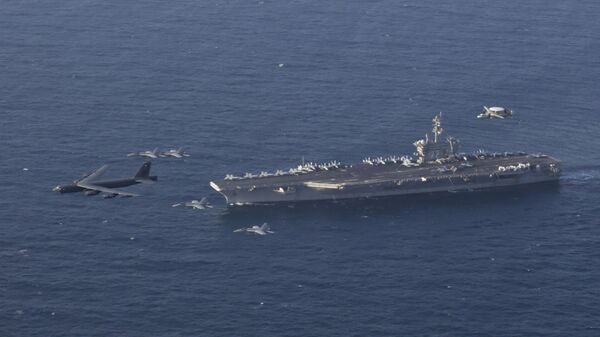The huge warship and its carrier strike group sailed through the Strait of Hormuz, a 21-mile-wide waterway connecting the Persian Gulf to the Red Sea, without incident on Tuesday, the US Navy said in a press release.
“A carrier brings immense capabilities wherever it goes,” Capt. Walter Slaughter, commanding officer of the Lincoln, said in the press release. “We place ourselves where we need to be, when we need to be there, in order to meet the full range of maritime security requirements of the mission at hand.”
The carrier sports an air wing of some 80 aircraft and was accompanied by several missile-armed destroyers and cruisers that also serve as anti-air and anti-ship defenses.
USNI reported the voyage was “safe and professional,” bereft of the harassment typically given US warships transiting the strait by Iran’s Islamic Revolutionary Guard Corps (IRGC), an elite paramilitary outfit that forms the backbone of Iran’s armed forces. The strait is almost exclusively owned by Iran, with which the US has been locked in a chest-beating match since US President Donald Trump reversed policy in 2018, pulling out of a multilateral deal and reimposing strangling sanctions on Iran.
A statement from the US 5th Fleet made clear, “The presence of the [Lincoln Strike Group] in the [Persian] Gulf does not represent escalation or a new policy toward Iran,” USNI reported.
The publication noted the move might actually be a sign of relaxing tensions, since in the event of a shooting war, the carrier strike group would want a vast ocean to maneuver in, not a narrow waterway like the Persian Gulf or Strait of Hormuz, where it would be vulnerable to Iranian anti-ship missiles.
One-fifth of the world’s seaborne oil trade and one-third of its liquefied natural gas passes through the Strait of Hormuz.
However, the US has in recent days made several moves against Iran, including announcing the introduction of new sanctions amid Tehran’s decision to enrich more uranium at its Fordow Fuel Enrichment Plant.
“There is no legitimate reason to enrich uranium," US Secretary of State Mike Pompeo said on Monday, noting the only acceptable amount of such material for Iran to have is “zero.”
Meanwhile, protests sparked over the weekend in cities across Iran quickly earned US support. Amid a hike in fuel prices for large purchases of petroleum products, protesters took to the streets in Mashhad, Shiraz, Kermanshah and Tehran, setting fire to cars and structures and getting in fights with the police. At least one officer and several protesters have been killed.
“As I said to the people of Iran almost a year and a half ago: The United States is with you,” Pompeo tweeted on Saturday. On Monday, he condemned "any acts committed by the government against the Iranian people."
Iranians pay some of the lowest gas prices on the planet, and the reduction in subsidies was intended to create funds for a new program to aid low-income families.
Iranian leaders have claimed the protests are being fanned by “foreign-backed thugs,” a conclusion shared at least in part by some other powers, such as the Russian Foreign Ministry.
“The US’s goal vis-à-vis Iran is nothing other than to disturb its security and set fire to the Iranian nation’s interests,” Iranian Parliament Speaker Ali Larijani said on Monday, according to Iran’s PressTV. “He [Secretary Pompeo] openly supports the immolation of the Iranian people’s properties through foolish shamelessness and opportunism, while calling it defending the Iranian people.”


